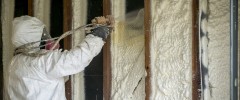Choosing the Correct Insulation for your Home
Heating and cooling requirements account for 50% to 70% of your home energy costs. Most homes – even new ones – do not have adequate insulation or insulated ductwork.
The benefits of properly selected and installed insulation include lower energy bills, natural resource conservation and increased in-home comfort. If you are wondering, “What material makes the best insulation?” you need to understand the related concepts of heat transfer and R-values.
Types of Heat Flow in Your Home
Heat flows into, out of and within your home in three ways: conduction, convection and radiation
- Conduction is the transfer of heat through materials, such as exterior walls and ceilings
- Convection is the transfer of heat from one part of your house to another via air flow
- Radiation is the transfer of heat in a way that does not depend upon any intermediary materials (medium) at all. Radiation heat passes easily through most traditional insulation materials – and even happens through empty space!
Factors that Affect Your Choice of Insulation Materials
Factors that will affect the selection of the right insulation for your home include:
- Take into account climate, building design & size, your living habits, and budget
- Use higher-density insulation on exterior walls or in cathedral ceilings
- Install attic vents to reduce moisture content and keep the attic cooler in summer, thereby lowering heating bills
What Are R-Values?
To understand the types of materials available to you for insulation against conduction and convection, you need to understand something called an R-value. This is a rating that indicates a material’s ability to resist heat flow; the higher the R-value of the insulation, the better it will resist heat transfer. Therefore, you should purchase your home insulation based upon R-value rather than on its material weight.
Best Materials For Reducing Conduction and Convection
Here are the four primary types of insulation for reducing heat conduction and convection:
- Rolls and bats, or blankets: these are flexible products made from mineral fibers such as fiberglass and wool. These are available in widths suited to standard spacing measurements between home wall studs, as well as in the spaces between attic or floor joists.
- Loose-fill insulation: this type of insulation is made of fiberglass, rock wool, or cellulose in the form of loose fibers or fiber pellets. It is blown into the spaces to be insulated using pneumatic equipment. The blown-in material does a great job of conforming to cavities and attics. Therefore, it is ideal for when it is tough to use other types of insulation due to the contours of the inside of the attic.
- Rigid foam insulation: Rigid foam is more expensive than fiber insulation. However, when higher R-values are needed, rigid foam is ideal. Its R-values are about 2 times higher than other types of insulation of a similar thickness.
- Foam in-place insulation: This type of insulation can be blown into walls and reduces air leakage when blown into cracks and door frames.




